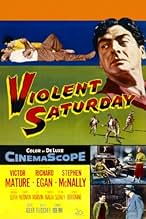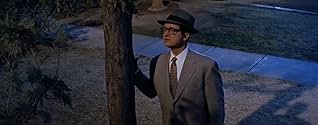IMDb रेटिंग
6.9/10
3.1 हज़ार
आपकी रेटिंग
तीन लोग एक छोटे शहर में बहुत ही सावधानी से, आने वाले शनिवार को बैंक को लूटने की योजना बनाते हैं, जो हिंसक और प्राणघाती हो जाता है.तीन लोग एक छोटे शहर में बहुत ही सावधानी से, आने वाले शनिवार को बैंक को लूटने की योजना बनाते हैं, जो हिंसक और प्राणघाती हो जाता है.तीन लोग एक छोटे शहर में बहुत ही सावधानी से, आने वाले शनिवार को बैंक को लूटने की योजना बनाते हैं, जो हिंसक और प्राणघाती हो जाता है.
- निर्देशक
- लेखक
- स्टार
Robert Adler
- Stan
- (बिना क्रेडिट के)
John Alderson
- Amish Farmer on Train
- (बिना क्रेडिट के)
Ellen Bowers
- Bank Teller
- (बिना क्रेडिट के)
Virginia Carroll
- Carol, Martin's Secretary
- (बिना क्रेडिट के)
Harry Carter
- Bart, Policeman
- (बिना क्रेडिट के)
फ़ीचर्ड समीक्षाएं
Combination crime-drama and soap opera, presumably a contract picture from Fox with many familiar faces (and Ernest Borgnine inexplicably cast as an Amish farmer!), turns out to be a pretty exciting movie. Three hoods plot to stick up a small town bank; meanwhile, hormones are boiling over at the new copper plant where the foreman's son is drinking himself into a stupor while his cheating wife runs around on the golf course ("You're an alcoholic," she tells him, "and I'm a tramp!"). There's also a married banker who lusts after a shapely nurse, a librarian with sticky fingers, and Victor Mature as a graduate whose oldest child is ashamed that his father never served his country. Director Richard Fleischer sets up the pieces of this story almost sluggishly, yet after about an hour of exposition the plot really starts cooking. There are some strong images here, and vivid cinematography by Charles G. Clarke (with excellent location shooting in Bisbee, Arizona and terrific usage of De Luxe color stock). The ensemble cast works admirably together, no one person upstaging the other; however, crooked Lee Marvin makes a fantastic entrance into town stepping on a child's hand in the street! Gripping, tense, and surprisingly well-written, with Richard Egan getting an emotional monologue at the end about the unfairness of death. An injured Amish child is forgotten about in the rush of excitement, and Borgnine in an Abraham Lincoln beard strains credulity, but the technical aspects and direction of the film are top-notch. *** from ****
"Violent Saturday" was not an outstanding movie, nor very original, but that is not to say that it had no merit. Richard Fleischer's direction goes much farther than skin-deep. From one angle, "Violent Saturday" is about a hold-up and the normal guy (Victor Mature) who tries to stop the criminals. That's fine, and there are some very exciting moments toward the end of the film. But another angle is more interesting: it's a study of what normal small-town-folks do in secret. Indeed, in comparison to the unscrupulous dealings of a voyeuristic bank manager, a larcenous librarian, and a trampy wife and her alcoholic husband, the sadistic bad guys (including a memorable Lee Marvin) seem less sinister. In its studies of the dynamics between husband and wife, parent and child, and its Everyman hero and hard-bitten villains, "Violent Saturday" is half a tribute to noir tradition, half a fifties family-drama. The mixture is sometimes uneasy. Particularly annoying are the conversations between doofy dad Mature and his cute little son who wishes his dad was more of a hero. But the drama between the weirder citizens of the little town is intriguing. A masterful use of the camera and Hugo Friedhofer's strident score are other assets. All in all, "Violent Saturday" is worth a look.
The wide-screen format was at most only two years old when this film was made. Yet, Charles G. Clarke's shot composition in the new wide-screen format is beautiful. This alone makes the film worth watching.
This is a good example of a color film noir; perhaps not as good as Niagara (1953) or Leave her to Heaven (1945), which were made by the same studio by the way (20th Century Fox), but still a good example from the noir cycle in color.
One way to understand film noir is that it is simply violent melodrama. Look at The Postman Always Rings Twice (1946) for example. Violent Saturday (1955) is steeped in melodrama, but there is also some extraordinary violence. And the violence here--in typical noir fashion--is the resolution--however bleak--to some of the melodramatic conflict.
The film has a profound cynicism grinding beneath the surface of the beautiful color photography. And this cynicism remains at the end of the film.
If you haven't seen this film and you are interested in film noir or film of this period, then I would highly recommend the Violent Saturday.
This is a good example of a color film noir; perhaps not as good as Niagara (1953) or Leave her to Heaven (1945), which were made by the same studio by the way (20th Century Fox), but still a good example from the noir cycle in color.
One way to understand film noir is that it is simply violent melodrama. Look at The Postman Always Rings Twice (1946) for example. Violent Saturday (1955) is steeped in melodrama, but there is also some extraordinary violence. And the violence here--in typical noir fashion--is the resolution--however bleak--to some of the melodramatic conflict.
The film has a profound cynicism grinding beneath the surface of the beautiful color photography. And this cynicism remains at the end of the film.
If you haven't seen this film and you are interested in film noir or film of this period, then I would highly recommend the Violent Saturday.
Thanks to FXM we can now see the widescreen version of Violent Saturday. Its a terrific, tense crime drama that must have been somewhat controversial in 1955. Certainly the onscreen violence is stronger than anything else I've seen from the period, except possibly Richard Widmark shoving the wheelchair down the stairs in Kiss of Death. There are definitely some hints of the future Hollywood of Sam Peckinpah--the sadistic Lee Marvin grinding a little boys hand into the ground, and a bearded Ernest Borgnine using a pitchfork on Lee towards the end of the film. Well worth catching.
The main reason I like this film is that the characters show what real people were like in 1955. It's a little like going back in time to an average american town where one observes various folks in everyday life including a variety of personal problems. Of course, I have always been nostalgic about the 50s as I spent my childhood in that era.
क्या आपको पता है
- ट्रिवियाOne of the lowest-budgeted films ever shot in CinemaScope and De Luxe color.
- गूफ़The car is started and put into gear so that it will crash through the barn door after which the engine stalls but, while it's still in gear, Stadt and Martin are able to easily push it out.
- भाव
Mrs. Emily Fairchild: Would you like me to have you thrown out?
Linda Sherman: Why don't you get mad enough to try it. All I want is an excuse to pull that hair right out of your stupid head.
[Mrs. Emily Fairchild looks away]
Linda Sherman: Guess you don't have the guts.
- कनेक्शनEdited into Verifica incerta - Disperse Exclamatory Phase (1965)
टॉप पसंद
रेटिंग देने के लिए साइन-इन करें और वैयक्तिकृत सुझावों के लिए वॉचलिस्ट करें
- How long is Violent Saturday?Alexa द्वारा संचालित
विवरण
बॉक्स ऑफ़िस
- बजट
- $9,55,000(अनुमानित)
- चलने की अवधि
- 1 घं 30 मि(90 min)
- रंग
- पक्ष अनुपात
- 2.55 : 1
इस पेज में योगदान दें
किसी बदलाव का सुझाव दें या अनुपलब्ध कॉन्टेंट जोड़ें


































